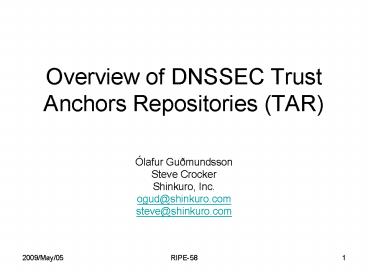Overview of DNSSEC Trust Anchors Repositories TAR - PowerPoint PPT Presentation
1 / 14
Title:
Overview of DNSSEC Trust Anchors Repositories TAR
Description:
Requires special code in validators to look up the DLV RR and associate with the ... Open issue: Should validators trust verified answers from DNS when it ... – PowerPoint PPT presentation
Number of Views:81
Avg rating:3.0/5.0
Title: Overview of DNSSEC Trust Anchors Repositories TAR
1
Overview of DNSSEC Trust Anchors Repositories
(TAR)
- Ólafur Guðmundsson
- Steve Crocker
- Shinkuro, Inc.
- ogud_at_shinkuro.com
- steve_at_shinkuro.com
2
What is a Trust Anchor Repository?
- Background paper http//www.dnssec-deployment.org
/tar/tarpaper.pdf - A collection of Trust Anchors from more than one
domain that is being made available - Why is TAR needed ?
- Not all parents are signed
- Parent publishes DS with digest that is not
universally supported - Many others
3
Open TAR issues
- Disagreement on what a TAR is
- Differing opinions on what TARs can list
- Limited experience
- No guidance to TAR operators or users
- This talk is aimed at starting a discussion on
BCP for TAR operation and use
4
TAR admission
- Each TAR should have a policy on how TA for a NEW
domain is added - Registration
- Simple submission, via email, http, or DNS
- Proof of possession tests
- Scanning/discovery
- Third party vouching (X.509 cert, PGP signatures,
members submit) - Aggregation of multiple TARs
- Accept TAs even if parent is signed?
5
TAR maintenance
- Each TAR should have a clear policy on how it
maintains its contents - SEP bit rule
- Should Keys without SEP bit be listed as TAs in
a TAR? - RFC5011 support
- Monitoring frequency
- Honor Revoke bit ? delete key as soon as it is
seen and validated - Registrant notifies TAR of update
- Same policy as new key or
- TAR checks DNS and pulls in new TA
- Should TAR still scan to detect changes ?
- What to do if changes are detected ?
6
Deletion of TA in TAR
- This is one of the sticky policies.
- When domain goes insecure or disappears
- When registrant requests ?
- What if there is no relationship ?
- What if TA abruptly changes?
- When does a TAR stop listing a TA with a signed
parent? - Not all domains in TAR may have DS in parent
- Clients need time to learn the parents TA
- What if TAR is using different digest algorithm
than the parent?
7
TAR access
- Technical
- DNS query, DNS zone transfer, rsync file, DB
lookup, email, etc. - Policy
- Who can access the TAR?
- Subscription policy
- Fee charged ?
- Who pays fee, registrant or user
- Definition
- DLV is one type of a TAR access.
8
TAR influence on zone operations
- Publish SEP bit on TAs
- TARs should ignore all keys w/o SEP bit
- RFC5011/Timers rollover procedure should be used
at all times. - Monitor known TARs for inclusion and correctness
- Hard to tell where all the TAR are or access
contents - Think spam black lists
9
Example ITAR (IANA Interim TAR)
- ITAR web site https//itar.iana.org/
- Admission
- Only TLDs can submit trust anchors
- Access
- Xml file containing DS records that would appear
in a signed root zone, via http, ftp, (rsync
failed for me April 29th 2009 and today) - Tool provided to convert to trusted-keys block
for Bind trust-anchors block for Unbound. - DNS presentation file format file
- Files are PGP signed, and file digests are
published. - Usage
- Add to Validators configuration file, no code
changes - Updates/deletions
- OWNER (i.e. TLD) submits to IANA
10
TAR examples ISC DLV
- ISC DLV site https//dlv.isc.org/
- Admission (hybrid)
- Registration with proof of access to key
- Registration via web form, challenge sent via
email - Includes ITAR contents
- Access
- DNS queries for ltnamegt.dlv.isc.org type DLV
- Requires special code in validators to look up
the DLV RR and associate with the name being
validated. - Anyone can access
- Updates/deletions
- Registrant, soon RFC5011
11
IKS-Jena TAR
- https//www.iks-jena.de/leistungen/dnssec.php
- Admission (hybrid)
- Scanning of TLDs and reverse tree looking for
DNSKEY RR - Has access to some TLD zone files
- Open registration
- Access
- http, DLV dnssec.iks-jena.de
- Updates/Deletes
- RFC5011
12
To be or not to be listed in a TAR
- Rathole?
- Can zone owner realistically control what someone
puts in their TAR? - DNS data is public information.
- Add signaling
- Is SEP bit the way to go?
13
TAR or DNS on top?
- Open issue Should validators trust verified
answers from DNS when it contradicts contents of
TAR or configuration? - Example parent is signed and has signed
delegation to the name.
14
Questions?































